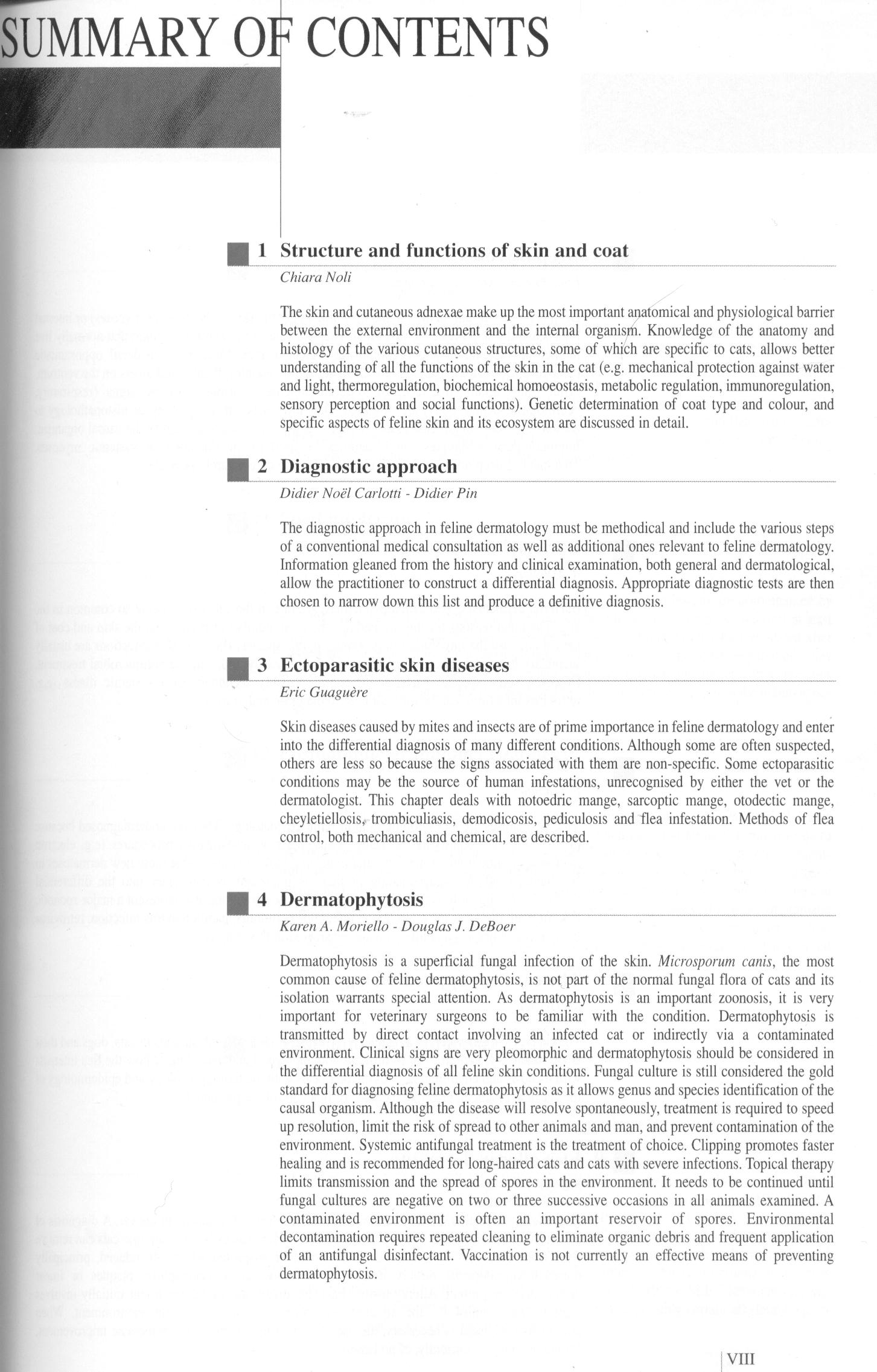2 (1621)

CONTENTS
SUMMARY OF

1 Structure and functions of skin and coat
Chiara Nołi
The skin and cutaneous adnexae make up the most important anatomical and physiological barrier between the extemal environment and the intemal organism. Knowledge of the anatomy and histology of the various cutaneous structures, some of which are specific to cats, allows better understanding of all the functions of the skin in the cat (e.g. mechanical protection against water and light, thermoregulation, biochemical homoeostasis, metabolic regulation, immunoregulation, sensory perception and social functions). Genetic determination of coat type and colour, and specific aspects of feline skin and its ecosystem are discussed in detail.
2 Diagnostic approach
Didier Noel Carlotti - Didier Pin
The diagnostic approach in feline dermatology must be methodical and include the various steps of a conventional medical consultation as well as additional ones relevant to feline dermatology. Information gleaned from the history and clinical examination, both generał and dermatological, allow the practitioner to construct a differential diagnosis. Appropriate diagnostic tests are then chosen to narrow down this list and produce a definitive diagnosis.
3 Ectoparasitic skin diseases
Erie Guaguere
Skin diseases caused by mites and insects are of prime importance in feline dermatology and enter into the differential diagnosis of many different conditions. Although some are often suspected, others are less so because the signs associated with them are non-specific. Some ectoparasitic conditions may be the source of human infestations, unrecognised by either the vet or the dermatologist. This chapter deals with notoedric mange, sarcoptic mange, otodectic mange, cheyletiellosis,- trombiculiasis, demodicosis, pediculosis and flea infestation. Methods of flea control, both mechanical and Chemical, are described.
| 4 Dermatophytosis
Karen A. Moriello - Douglas J. DeBoer
Dermatophytosis is a superficial fungal infection of the skin. Microsporum canis, the most common cause of feline dermatophytosis, is not part of the normal fungal flora of cats and its isolation warrants special attention. As dermatophytosis is an important zoonosis, it is very important for veterinary surgeons to be familiar with the condition. Dermatophytosis is transmitted by direct contact involving an infected cat or indirectly via a contaminated environment. Clinical signs are very pleomorphic and dermatophytosis should be considered in the differential diagnosis of all feline skin conditions. Fungal culture is still considered the gold standard for diagnosing feline dermatophytosis as it allows genus and species identification of the causal organism. Although the disease will resolve spontaneously, treatment is required to speed up resolution, limit the risk of spread to other animals and man, and prevent contamination of the environment. Systemie antifungal treatment is the treatment of choice. Clipping promotes faster healing and is recommended for long-haired cats and cats with severe infections. Topical therapy limits transmission and the spread of spores in the environment. It needs to be continued until fungal cultures are negative on two or three successive occasions in all animals examined. A contaminated environment is often an important reservoir of spores. Environmental decontamination requires repeated cleaning to eliminate organie debris and frequent application of an antifungal disinfectant. Vaccination is not currently an effective means of preventing dermatophytosis.
VIII
Wyszukiwarka
Podobne podstrony:
Pre-requisite(s): AC1117 or equivalent Co-requisite(s): Nonę Module Content: Capital structure and d
5 (2050) CONTENTS PREFACE PART 1 GENERAL PRINCIPLES OF RELAXATION AND STRETCHING OF MUSCLES AND OTHE
232 CONTENTS Karol Krajewski REASONS. DIRECTIONS OF DEYELOPMENT AND SEGMENTA TION OF FUNCTIONAL FOOD
amorf3 suo Figurę 15.3. (a) Structure factor and (b) its pair distribution function of liąuid and am
Topie 1, DESCRIBE THE OPERATION OF DATA NETWORKS (75 ąuestions)Section 1: Describe the purpose and f
7 Tait, R. D., R. J. Shiel & W. Koste, 1984. Structure and dynamics of zooplankton communities,
Fig. 3. Behavior of CO and C02 conceniration in the stack gases as a function of stoichiometric raii
i. Introduction CCT diagrams are used for detennination of the phase structure and hardness of steel
IMG 88 (3) Functions of secretory immunoglobulins 1. Immune 6xclusion / Secreted IgA binds to microb
netter155 Gallbladder Structure and FunctiunGASTROINTESTINAL PHYSIOLOGY R. and L hepatic duets R. an
netter52 Fxcitation-Conlraclion CouplingMUSCLE PHYSIOLOGY HART 3.1 COMPARISION OF MUSCLE STRUCTURE A
Structure and Thermoelectric Properties of the Vapor-Phase Condensation LAST Rostyslay Jaworski. Jar
CONTENTS EDITORIAL 5 METHODOLOGICAL AND HISTOR1CAL PERSPECTIYE OF BUSINESS ETHICS Wojciech
7 Food self-supply and income of rural households The changes that manifest themselves in the functi
CONTENTS FIELD WORK AND MATERIAŁ Neolithic and Early Bronze Age Włodzimierz Wojciechowski, Results o
THE INFLUENCE OF THE GROWTH TEMPERA TURĘ ON STRUCTURAL AND... 161 c.d. tab.
18 Felczak T., Domańska T. THE STRUCTURE AND LEVEL OF DEBT AND THE EFFICIENCY OF INDIVIDUAL FARMS, D
więcej podobnych podstron